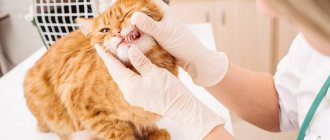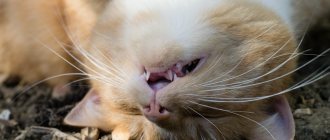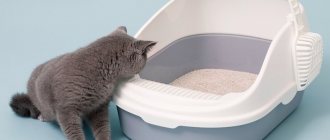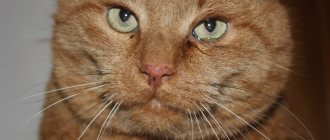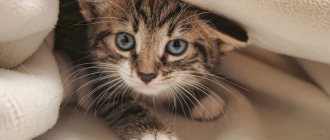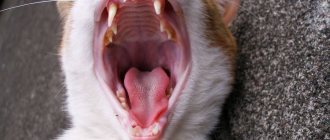Causes of cough
You can figure out why your cat is coughing and whether it requires treatment by correctly assessing the accompanying signs. Symptoms and timing of attacks should be recorded. As a rule, a cat's cough is a symptom of another disease. Mustachioed pets may become hoarse after mating due to shouting loud sounds.
Cough may be a symptom of a dangerous disease
Respiratory cough
Respiratory cough can be caused by bacterial, fungal or viral infectious diseases. In these cases, it is important to determine the reason why the cat often coughs in order to prevent the development of infection. A cat's cough is accompanied by the following diseases:
- rhinotracheitis;
- mycoplasmosis;
- laryngitis;
- bronchitis, etc.
Note! Initially, the animal experiences a frequent, loud, dry cough. After a few days of illness, it becomes moist with sputum production.
The course of the disease has the following symptoms:
- mucus discharges from the nose;
- weakness of the body;
- suppuration of the eyes;
- elevated body temperature.
Sphinxes at an early age have weak immunity and are susceptible to various diseases.
Almost all respiratory diseases are transmitted to a pet by airborne droplets. The infection can be brought into the house by the owner or guests through contaminated shoe soles.
Heart diseases
Problems with the heart affect neighboring organs and the respiratory tract due to increased pressure. Therefore, the cat’s body cannot detect the disease and tries to cope on its own with the help of a muffled cough. There is no nasal discharge.
Traumatic and complex causes of cough
The cause of the disease can be accumulation of air, pus, and fluid in the chest area. This (hydrothorax) can be caused by factors such as a tumor, heart problems, allergic reactions and inflammation.
Note! For an accurate diagnosis, you need to take a puncture of the fluid collected in the chest.
After physical trauma or infection, both air (pneumothorax) and pus (pyothorax) can accumulate in the chest.
During fights, cats strike with their claws and can tear out pieces, causing infection to their opponent.
These diseases are very serious. For example, pneumothorax develops quickly: air fills the chest, compresses the lungs, and the pet suffocates.
Allergy
Your cat may be coughing due to allergies. You should find the allergen and not allow the animal to interact with it or be near it. If the variant is advanced, drug treatment is needed.
Infectious and viral diseases
The most common causes are herpes virus, calicivirus, and rhinotracheitis. They affect the mucous membranes of the nasopharynx and eyes.
If a cat coughs due to a viral infection, it will experience the following symptoms:
- the mucous membranes of the nose and eyes become inflamed;
- temperature rises;
- the cat's neck stretches, the throat becomes red;
- a hoarse sound is heard;
- sneezing.
If your pet continues to sneeze and cough for several days, it is best to contact your veterinarian. Infectious diseases will not go away on their own; without help, the kitten may die.
Important! Kittens are vaccinated against rhinotracheitis and calcivirosis from the age of 3 months.
Helminths
Worms can also cause coughing. Almost every cat often has worms.
Important! A cat can become infected with helminths without going outside or having contact with animals.
Once the worm has entered the body, it spreads to various organs, including the lungs. The animal notices a foreign object inside the lungs and tries to cough up. However, a coughing attack is not accompanied by parasite discharge. Without human help, the furry animal will not recover.
Oncological diseases
Tumors and metastases in the lungs also cause coughing. These pathological processes are more common in cats older than 8 years.
X-ray shows metastases in the lungs, causing coughing
Timely diagnosis can identify malignant neoplasms at the initial stages. The animal can be treated surgically and medically. In advanced forms, when metastases have penetrated into the lung tissue, the mustachioed are supported with the help of chemotherapy and radiation.
Foreign object
You should understand that when a cat coughs, it makes a characteristic wheezing sound because it has choked, and has not caught a cold. A cat may choke while eating food or an inedible object.
Signs of cough due to mechanical damage:
- the animal has swallowed a small object, toy, plastic, thread, insect, bone, etc. Due to a sharp stuck bone, breathing difficulties and bleeding may begin;
- in addition to coughing, the kitten may wheeze and experience a gag reflex;
- pets rub their faces with their paws, trying to get rid of a foreign object;
- tailed animals can press themselves to the floor, open their mouths strongly, stretch out their tongues and stretch out their necks. These movements try to suppress the cough reflex;
- there is strong salivation.
Important! If you are unable to remove the foreign body yourself, you should go to the veterinarian, who will push it, remove it, or perform surgery.
Asthma attacks
An asthma attack is also accompanied by coughing and wheezing breathing. The cat tries to clear his throat, sits with his head down and his neck outstretched. During this, the cat may stick out its tongue. He may lose consciousness, his lips turn blue, and his eyes roll back in his head.
Treatment should only be prescribed by a doctor after taking all tests, examining the chest and gastrointestinal tract. It is better to have an inhaler at home that can relieve a coughing attack and prevent you from suffocating.
Pneumonia
Its symptoms are often similar to other respiratory diseases. Signs of pneumonia:
- labored breathing;
- shortness of breath;
- purulent nasal discharge;
- wheezing;
- heat;
- cyanosis of the mucous membrane;
- swelling of the dewlap.
Pneumonia requires immediate treatment.
Is it possible to treat an animal yourself?
If a person has enough experience, then in most cases treatment can be carried out directly at home. It is often not difficult for an experienced pet owner to clear the airways of a foreign object, such as a stuck fish bone.
If the cough is a consequence of an allergic reaction, think about what new item has appeared in the house, because it could have triggered the reaction. In this case, it is enough to simply get rid of the dangerous object.
In the case of worms in an animal, buy an effective remedy, follow the instructions and you can remove them without problems at home, without the help of a veterinarian. Having killed the worms, the symptoms should stop soon.
How does cough manifest in cats?
The dog is coughing as if choking: why and what to do
The cough reflex is a necessary phenomenon in animals. Thanks to it, they get rid of particles that irritate the respiratory system. During the process, dust, fur, blood, pus, and parts of food may be coughed up.
For your information! A cough occurs during a strong exhalation, which is accompanied by a loud sound. Muscle contraction also occurs, pushing out interfering objects.
An animal can cough once, at a certain time (seasonal cough) or constantly. During attacks, you need to record the following signs:
- duration;
- manifestation period;
- what discharge is present/absent. Vomiting may occur with a wet cough;
- power. The cough may be mild, with hacking and profuse vomiting.
Signs and types of wheezing
Wheezing is understood as noisy breathing, against the background of which a combination of many wheezing and whistling sounds is heard. Such deviation from normal breathing is a frequent companion to most pathologies of the animal’s respiratory tract.
Wheezing can occur for two reasons:
- in the process of narrowing the lumen of the respiratory tract;
- due to the accumulation and foaming of fluid in the respiratory system.
Noises and wheezing when breathing do not bode well
In addition, wheezing means a hoarse, strained voice or its complete absence. This pathology occurs due to incomplete closure of the vocal cords due to the accumulation of mucus in the glottis, which is a common symptom of many inflammatory processes.
Reasons that lead to loss of voice:
- Respiratory diseases are one of the common causes of wheezing when breathing in a cat. We are talking about various viral and infectious diseases that can be picked up by hypothermia in the cold season. It could be a cold or acute respiratory infection.
- Advanced respiratory diseases can lead to the development of pneumonia, viral feline rhinotracheitis, tonsillitis, calcivirosis or bronchial asthma, a common symptom of which is also loss of voice and wheezing.
- A foreign body in the larynx mechanically damages the surface of the pharynx due to the inability to swallow or regurgitate. This ultimately leads to the cat wheezing when he breathes. A pet can injure its throat with a thin or broken chicken bone, a tree branch, or choking on a spruce needle. Such damage is dangerous due to the high probability of a foreign object entering further into the digestive tract, injuring the upper respiratory tract and esophagus.
- Heart pathology. If the cat begins to show less activity, preferring to lie down instead of playing, walks slowly towards the bowl, as if overcoming obstacles, and upon reaching the goal, chokes, coughs or sneezes, this may be a sign of the development of heart pathologies. Often, owners are not even aware of the onset of heart problems in their cats due to the absence of symptoms. The disease develops, the body reaches a critical point, and after that symptoms appear and increase exponentially. A hoarse cat suffers from severe shortness of breath even after the slightest exertion. She has cold paw pads and ears, pallor of visible mucous membranes (gums, palate, eyes) due to poor blood circulation, in severe advanced cases, audible wheezing in the cat and bubbling in the chest, cold surface of the skin throughout the body.
The cat is trying to vomit a small object stuck in its throat
- Blood pathologies with a lack of iron in the body can also cause difficulty breathing with wheezing.
- With asthma, a cat wheezes and wheezes, presses to the floor, coughs, stretching its neck. As the disease progresses, severe shortness of breath and wheezing, even suffocation, appear.
- Pulmonary edema in a cat is an abnormal accumulation of fluid in the lungs, which is a consequence of various diseases of the internal organs and inflammatory processes. In this case, the cat wheezes when breathing with gurgling. He feels lethargic, phlegmatic, and desires to constantly sleep. The pet opens its mouth slightly with its tongue hanging out when breathing, inflating its belly and sides, trying to squeeze out liquid by coughing and swallowing; when coughing up, traces of blood, a bluish tint to the oral mucosa, and mucus from the nose may appear. A common urge of a cat is to expand its chest by standing in a position with its paws spread wide apart. Deterioration of the condition forces the cat to stretch out on its side.
- The accumulation of large amounts of fluid can be not only in the lungs, but also in the abdominal cavity. This pathology is called abdominal ascites, or dropsy. The pressure of the accumulated fluid compresses the internal organs, disrupting their activity. If dropsy is not treated in time, it can lead to the death of your pet.
Asthma can cause your cat to suffocate if you don't take action.
- The kitten wheezes when breathing with swelling of the larynx or laryngospasm, which appears due to poisoning with household chemicals. Such wheezing may be caused by an allergic reaction to tobacco smoke, dairy products, construction dust or strong odors.
- Oncology. From the second stage onwards, cancer is characterized by dysfunction of the respiratory system: the cat breathes heavily with wheezing, shortness of breath.
- Injuries due to improper handling by the owner, a fight with other cats, or an unsuccessful fall can cause damage to internal organs, including the respiratory system, so the cat may become hoarse.
- Tracheitis occurs due to many reasons: hypothermia, infection with a viral or bacterial pathogen, overdrying of the trachea during sleep during the heating season, evaporation of construction and paint materials. A strong barking cough and sore throat cause pain for the cat and cause loss of voice.
When observing how a pet coughs, one involuntarily draws an analogy with a human cough. But unlike a person, when coughing they stand in a certain position, stretching their neck forward as much as possible, making sounds reminiscent of an attack of vomiting.
By its nature, the cough mechanism is carried out as a result of strong irritation of the receptors of the mucous membrane lining the respiratory tract (nasal passages, bronchial tree or the lungs themselves).
READ How to give Enterol to a cat
Quite often, the cause of a severe cough in a cat is inflammatory processes occurring in the respiratory tract. As a result of a developed pathological process, a large accumulation of a specific secretion – mucus – occurs in the lumen of the larynx.
The body is trying to get rid of the irritating factor. A signal is transmitted to a certain center of the brain, transmitted along nerve endings, provoking irritation of the cough center. From this center impulses go to the larynx. Against the background of this process, the muscle fibers located in the larynx under the influence of the reflex contract.
When exhaling, the glottis is open, which is why a specific sound called a cough occurs. The owner’s task is to promptly detect such a sound being made and the posture being taken. This will make it possible to promptly contact a specialist for help, preventing the development of possible complications.
It is necessary to know what types of cough exist in veterinary medicine, their characteristic features and the consequences they have for the normal condition of the pet.
Veterinarians divide cough in domestic cats into several types. The cough can be acute or chronic.
The acute form of cough is characterized by a sudden appearance of the reflex, and the duration ranges from several days to 1 week.
A chronic type of cough can last from several weeks to several months.
Coughs are also classified according to their sound - muffled and loud, and according to the nature of the accompanying discharge - dry or wet.
In turn, the dry type of cough has its own symptoms. The cat wheezes, and the cough that escapes is abrupt and loud.
The wet type of cough is characterized by the appearance of peculiar gurgling sounds, accompanied by the release of mucous secretions, sputum, or even blood.
The time of day when a dry or wet cough appears is completely unimportant.
With a weak cough, the animal does not particularly strain. But for a strong one, the following clinical picture is typical - the cat coughs and wheezes, stretching out and snuggling, as if she had nausea and vomiting.
The pet owner should note any peculiarities when the cat coughs, which will allow the veterinarian to create a more accurate picture of what is happening when collecting an anamnesis and determine the exact factor that provoked the pathology. In addition, a detailed medical history makes it possible to choose the correct and most effective treatment tactics.
READ The dog has colic: intestinal, liver, kidney, stomach
If there is not only a cough, but also a stuffy nose in a cat, this type of pathological process is called respiratory. Body temperature may increase, and the general condition is depressed.
A set of symptoms along with a cough may indicate the onset of an inflammatory process in the lungs or bronchial tree. Characteristic symptoms do not appear immediately, but after a certain period of time. With increasing symptoms, the cough will be loud and dry, without secretions of specific secretions, sputum and blood.
Another type of cough is also defined in veterinary medicine – cardiac. The cardiac type of cough develops due to pathological processes occurring in the myocardium. This cough is not accompanied by the production of sputum and mucus.
The main cause of cardiac cough is severe thickening of the myocardial walls or the accumulation of pathological exudate in the pulmonary structures, provoked by disturbances in the circulatory system. With a cardiac cough, the following symptoms are observed - the cat is breathing heavily, as if she does not have enough air. Instead of nasal breathing, inhalation through the mouth is noted.
A cough can occur as a result of irritation of the mucous membranes by foreign protein components - an allergic reaction. With a weak reaction, the pet may simply cough from time to time, and there may be discharge from the nose.
Severe allergies can cause coughing to such an extent that the animal begins to choke. In such cases, it is necessary to urgently contact a 24-hour veterinary clinic for immediate help.
Diagnosis of the condition
Why does a cat shake its tail as if marking?
During diagnosis, the reasons that led to the cough are determined. The veterinarian conducts a thorough examination of the patient and collects anamnesis.
Only a specialist can make a correct diagnosis
If your cat sneezes while coughing, it may be cat flu. If wheezing is present, it may be asthma. When there is diarrhea, weight loss is observed, this most likely indicates the presence of parasites.
After diagnosis, the doctor prescribes the necessary tests and treatment.
How can you tell if your cat is not just coughing, but choking?
An animal can choke if a foreign body, usually small in size, gets stuck in the throat or esophagus.
The following factors allow you to understand that a cat is choking and not sick:
- eating before the first symptoms appear;
- the cat does not take the standard posture for a normal cough;
- there is no cough, but there is wheezing and vomiting;
- touches the muzzle with its paw, tries to remove the disturbing object itself;
- saliva is produced abundantly, it flows abundantly from the mouth, the animal is not able to swallow it.
The presence of these signs indicates that the cat is choking and assistance must be provided.
Antitussives
The dog grunts as if he is suffocating and choking.
Without consulting a veterinarian, it is strictly forbidden to purchase and give medications to your pets on your own, because you can only aggravate his condition.
Antitussive drugs can be divided into 3 groups:
- blocking. Helps quickly relieve cough. However, drugs in this group do not treat the cause, but rather “turn off” the cough center. Thus, the cough supposedly goes away, but the pet’s well-being worsens;
- expectorants. In case of infectious diseases, they help dilute sputum and remove it;
- with a complex effect. They combine blocking and expectorant properties. These include cough tablets for humans, but not all of them are suitable for the cat's body.
Treatment of cough in cats
Therapy is determined by the complexity of the pathological process and is aimed at eliminating it:
- For invasive cough, antiparasitic procedures are prescribed, and in the future it is recommended to regularly prevent the disease.
- Attacks due to cardiac problems are eliminated by comprehensive treatment of the cardiovascular system and general cough suppressants.
- The specificity of antiviral and antibacterial therapy is determined by the characteristics of the cough: expectorants are prescribed for dry coughs, and antitussives for wet coughs.
- Asthmatic attacks are stopped by hormonal and glucocorticosteroid, antiallergic drugs.
- Special creams and pastes improve the condition of trichobezoar. They cover the surface of hairballs and facilitate their natural release.
- Cough from injuries to the respiratory organs and throat subsides as they heal. If internal organs are injured, the pet is given crushed food. For external wounds, treatment methods depend on the severity of the pathology. In serious situations, the wound is surgically sutured and antibacterial therapy is carried out.
Be sure to read:
We suggest you read: Why do cats lose their voice and how to help them. What to do if your cat has lost his voice What to do if your cat is hoarse
The cat eats poorly and loses weight: causes, safe and dangerous symptoms, first aid, treatment
A sick animal should have access to water, but it should not be forced to drink.
Veterinarians often combine antitussive therapy with immune restoration.
Treatment for cough in cats is prescribed depending on the diagnosis, symptoms and many other associated factors. Medicines for pets are sold in veterinary pharmacies and can be in the form of tablets, capsules, drops and injections. As a rule, each remedy has an expectorant, antibacterial and immune system-restoring effect. Treatment is carried out at home and takes from two weeks to several months, depending on the disease.
During the recovery period, bed rest and complete calm are required; the animal must be protected from other pets, if there are any in the house. And in order for the cat to recover faster, it should be surrounded with care, affection and attention.
Medicinal herbs and cough preparations
It should be borne in mind that the use of folk remedies can cause even greater damage to the body. Therefore, it can be used provided that the veterinarian allows it.
Effective natural cough remedies include eucalyptus, thyme, linden, birch and pine buds, wild rosemary, lungwort, anise, etc.
A decoction of licorice root softens coughs and removes phlegm. Ingredients: 1 tbsp. spoon of chalked root in 1 glass of water.
Dry licorice root should be crushed before preparing the decoction.
The root is poured with cold water and left overnight. In the morning, the contents are boiled over low heat for about 10-15 minutes. Next, filter through a sieve and cool. You can give your cat half a teaspoon of the broth 3-4 times a day.
An infusion of coltsfoot leaves has a strong expectorant effect. Ingredients: crushed dried or fresh coltsfoot - 2 teaspoons, boiling water - 1 cup.
You need to pour hot water over the weed, cover the container with the contents and put it in a warm place for half an hour. After straining, give to the cat 3 times a day.
Coltsfoot leaves are most often used for infusion.
Cough prevention
Prevention is as follows:
- an important condition is timely vaccination;
- check with a veterinarian every six months;
- anti-parasite medications should be given regularly. Thus, you can avoid many diseases that are carried by fleas, ticks, and parasites;
- It is important to prevent your pet from coming into contact with sick or stray animals.
You should not allow a mustachioed animal to come into contact with sick animals.
Note! If your pet coughs when eating, you need to pay attention to its diet. Solid food pellets can be soaked in water. When eating natural foods, you should not give fish with bones or tubular chicken bones.
A cat's cough can be caused by various causes, which an experienced veterinarian can determine. In case of frequent severe attacks, you should immediately seek help from a specialist who will prescribe appropriate treatment.
How to treat wheezing breathing
After making a diagnosis, the veterinary specialist outlines a clear treatment regimen. It is necessary to follow all recommendations, adhering to the treatment regimen. Otherwise, the animal’s condition may worsen due to developing complications.
A cough with wheezing diagnosed in a cat that occurs due to trauma to the respiratory tract requires immediate intervention and surgical intervention. Any delay will result in death due to asphyxia.
Treatment for a cat's cough with diagnosed helminthiasis begins with special antiparasitic agents. The choice, dosage and duration of treatment directly depend on the type of parasite. Lungworms are removed by prescribing drugs such as Milbemax, Stronghold, Kanikquantel.
Treatment for cats with coughs caused by viral and bacterial factors includes a mandatory course of antibiotics. This is especially important when diagnosed with pneumonia. The specialist individually selects the type of drug, quantity and duration of the therapeutic course.
Diagnosed cardiac cough requires a special approach. Animals with heart disease should be monitored, noting any changes in condition.
Cardiac medications are prescribed, with constant monitoring of the work of the myocardium and blood circulation.
For bronchial asthma, treatment is carried out with hormonal drugs - glucocorticosteroids and bronchodilators. A cat with bronchial asthma should be protected from irritating factors - cigarette smoke, dust in the room, poor-quality food and chemicals. In the early stages of treating asthma in cats, antihistamines have proven themselves to be effective.
In order to prevent coughing in your pet, veterinarians and breeders strongly recommend following a number of rules. It is important to keep the animal in a well-ventilated area that is protected from drafts.
It is necessary to regularly carry out wet cleaning in the house, especially on cabinets and under beds, where pets most often like to be.
A necessary measure to prevent the development of cough in a cat is to avoid hypothermia of the animal, especially in the autumn-winter period. It is also important to carry out regular antiparasitic treatments and monitor the quality of the diet.
Viral and some bacterial infections can be prevented by timely immunization of pets.
Normal breathing in a cat is a calm and uniform rise and fall of the chest, without jerks or convulsive movements. If a cat breathes from its stomach and sides, this means that the respiratory tract is impaired, and it is painful for the pet to breathe naturally. Worry should be caused by the appearance of wheezing or loss of voice.
If a cat wheezes, it means he is sick with something.
Note! If a cat wheezes quietly while breathing during sleep, and there are no convulsive sighs or wheezing, this is normal.

